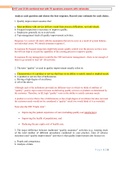Exam (elaborations)
Nursing C157 and C128 combined test with 70 questions answers with rationales
- Course
- Institution
Nursing C157 and C128 combined test with 70 questions answers with rationalesNursing C157 and C128 combined test with 70 questions answers with rationales
[Show more]



